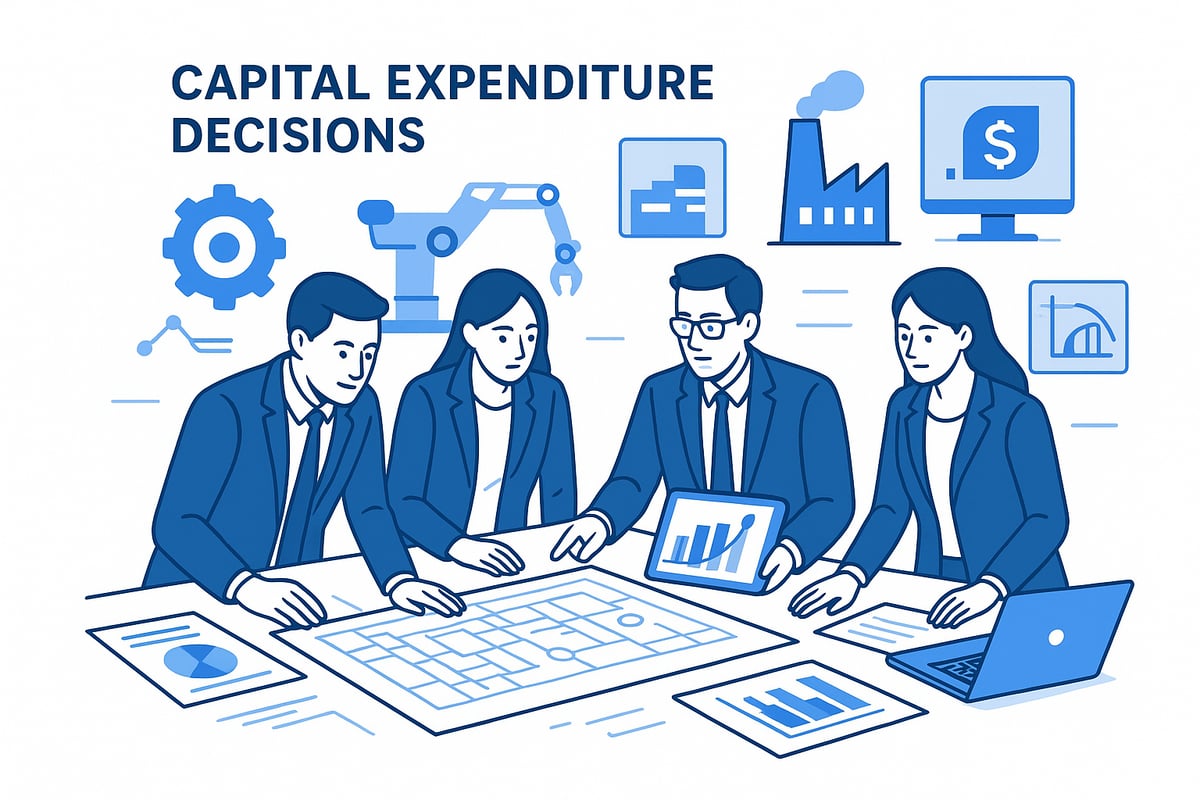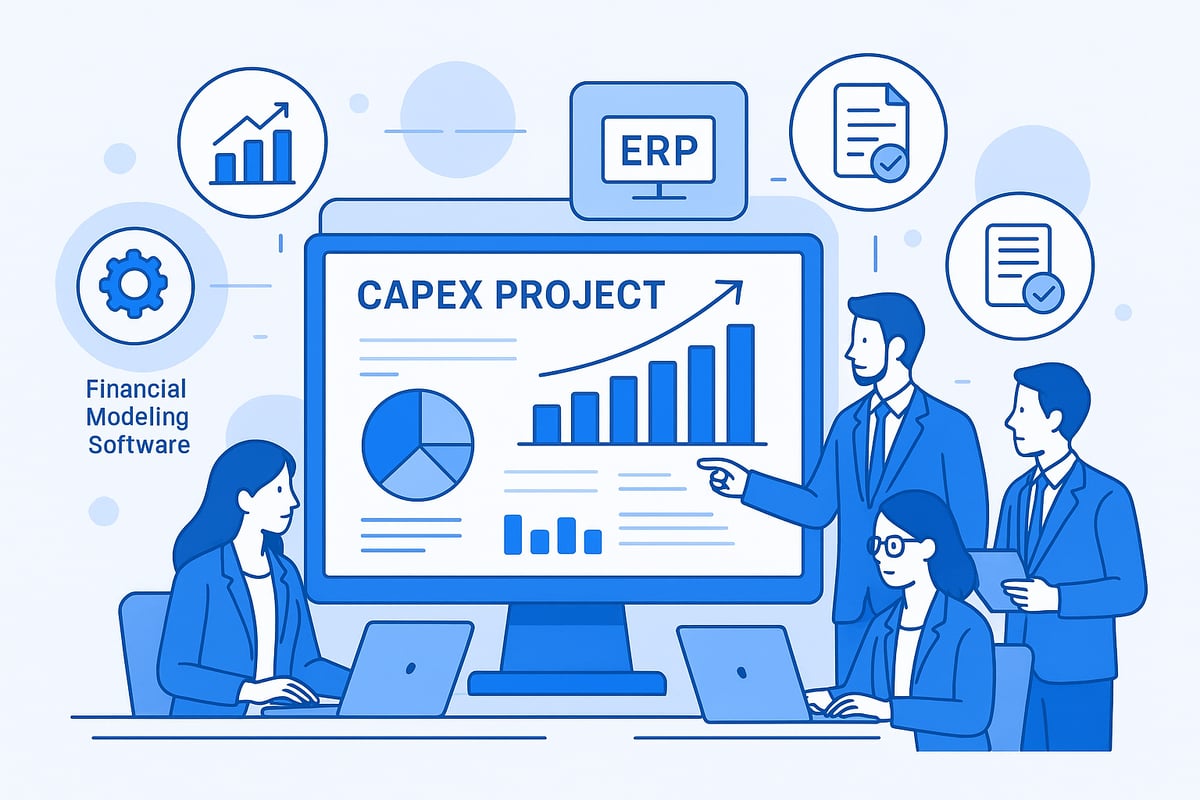Capex Guide 2025: Strategies for Smarter Investments
In 2025, capex decisions have never carried greater weight for organizations facing economic unpredictability and the relentless pace of technological innovation. Every investment choice can determine a business’s ability to grow, compete, and adapt to changing markets.
This comprehensive guide is designed to help finance leaders, managers, and investors optimize their capex strategies for long-term success. You will discover proven frameworks, data-driven tools, and best practices that maximize returns and reduce risk.
Ready to make smarter, more resilient capex investments? Explore fundamentals, emerging trends, risk mitigation, step-by-step planning, the latest technology, and tailored industry strategies—all in one place.
Understanding Capex: The Foundation for Smarter Investments
Capital expenditure, or capex, forms the backbone of any organization’s long-term growth strategy. It encompasses investments in assets, infrastructure, and technology that drive innovation and competitiveness. Unlike operational expenditure, which covers daily running costs, capex funds major purchases such as machinery, IT upgrades, or property. These decisions directly impact business value, future cash flows, and even tax liabilities. To clarify key financial terms involved in capex, consult this financial terms glossary. Misunderstandings often arise when companies misclassify expenses or underestimate the strategic significance of capex on their balance sheets.

What is Capex and Why Does It Matter?
Capex refers to the funds a business uses to acquire, upgrade, or maintain physical assets. It is distinct from operational costs, which are recurring and short term. Capex supports business expansion, modernization, and competitive advantage. For example, a manufacturer might invest in new robotics, while a retailer purchases additional storefronts. According to CFI, capex is a key driver of company valuation and future cash flows. Capex decisions influence financial statements through depreciation and can have significant tax implications. Common pitfalls include confusing capex with opex or neglecting the long-term strategic impact of these investments.
Key Capex Metrics and Formulas
Understanding capex requires familiarity with essential metrics and calculations. The net capex formula is: Capex = Current PP&E – Prior PP&E + Depreciation. Analysts also examine capex as a percentage of revenue to benchmark against industry peers. Key evaluation tools include payback period, internal rate of return (IRR), and net present value (NPV). For example, if a company spends $1 million on equipment and expects $200,000 annual returns, the payback period is five years. Accurate capex forecasting is crucial, as it affects EBITDA and other financial ratios. Industry averages show capex ratios vary widely, emphasizing the need for tailored budgeting.
| Metric | Formula / Description |
|---|---|
| Net Capex | Current PP&E – Prior PP&E + Depreciation |
| Payback | Investment / Annual Cash Flow |
| IRR, NPV | Discounted cash flow analysis |
Types of Capex Investments
Capex investments fall into several categories. Growth capex fuels expansion, such as entering new markets or launching new products. Maintenance capex, on the other hand, preserves existing assets and operations. Tangible capex covers physical items like buildings or vehicles, while intangible capex includes software or patents. Expansionary capex supports new initiatives, whereas replacement capex updates old assets. For instance, a manufacturing plant upgrade represents replacement capex, while a retail chain’s expansion is growth capex. Industry patterns differ: tech firms focus on software, manufacturing on machinery. Asset lifecycles and depreciation schedules must be considered to optimize capex allocation.
| Type | Example | Strategic Focus |
|---|---|---|
| Growth | New store opening | Expansion |
| Maintenance | Equipment overhaul | Asset longevity |
| Tangible | Property purchase | Physical assets |
| Intangible | Patent acquisition | Intellectual value |
Common Capex Challenges in 2025
In 2025, organizations face mounting capex challenges. Rising costs, fueled by inflation and supply chain issues, complicate budgeting. Regulatory demands and ESG compliance add further pressure, requiring investments in sustainable assets. Rapid technology shifts create risks of obsolescence and integration difficulties. Aligning capex with long-term strategy is difficult, especially when economic uncertainty prompts project delays. According to recent surveys, finance teams cite cost overruns and governance gaps as top hurdles. Robust capex governance and internal controls are now essential to safeguard investments and optimize outcomes.
Emerging Capex Trends and Market Forces for 2025
In 2025, capex strategies are being shaped by a rapidly changing economic and technological landscape. Finance leaders must navigate a maze of global uncertainties, digital disruption, sustainability demands, and sector-specific shifts. Understanding these emerging trends is critical for making informed, future-ready capex decisions.

Economic and Market Drivers
The global economic outlook for 2025 is both promising and complex, with capex budgets influenced by shifting interest rates and persistent inflation. Companies are revising investment plans in response to evolving monetary policies and geopolitical uncertainties. For instance, post-pandemic recovery has led to a reallocation of capex toward resilient infrastructure and technology.
Regional differences are significant. North America and Asia-Pacific are seeing robust capex growth, while some European sectors remain cautious. According to the Capital Expenditure Market Outlook 2025–2032, key trends include digital adoption and a focus on strategic, long-term projects. Inflation continues to challenge accurate project cost estimation, making scenario planning essential.
Technology and Digital Transformation
Digital transformation is at the heart of capex planning for 2025. Organizations are prioritizing investments in automation, AI, cloud infrastructure, and the Internet of Things. These technologies are not only modernizing operations but also enabling smarter, data-driven capex allocation.
Sectors like construction and manufacturing are increasing their capex for robotics and advanced analytics. In 2025, IT-related capex is projected to account for a significant portion of overall spend, as companies deploy ERP systems and digital dashboards for real-time project tracking. However, keeping pace with rapid tech evolution remains a challenge for many finance teams.
ESG and Sustainability in Capex
ESG compliance is rapidly becoming a core driver in capex decisions. Companies are investing in green capex, such as renewable energy systems, electric vehicle fleets, and sustainable buildings, to meet both regulatory requirements and stakeholder expectations.
Regulatory incentives are encouraging organizations to prioritize energy efficiency and low-carbon assets. Industry benchmarks show that ESG-related capex now represents a growing share of total investment, particularly in sectors like utilities and real estate. Ignoring sustainability in capex planning can expose organizations to reputational and financial risks, while ESG-focused investments often create long-term value.
Industry-Specific Capex Trends
Capex trends in 2025 are highly sector-dependent. Manufacturing is channeling resources into automation and supply chain resilience. Construction is embracing modular building techniques and smart infrastructure. The technology sector is investing heavily in data centers, cybersecurity, and software innovation.
Retailers are focusing capex on omnichannel experiences, logistics, and digital storefronts. Healthcare providers are upgrading medical equipment and expanding telehealth infrastructure. Recent data highlights strong capex growth in technology and healthcare, with notable projects announced across all major industries.
| Sector | Key Capex Focus (2025) |
|---|---|
| Manufacturing | Automation, robotics |
| Construction | Modular, smart buildings |
| Technology | Data centers, cybersecurity |
| Retail | Logistics, digital stores |
| Healthcare | Equipment, telehealth |
Capex Risk Management in a Volatile World
Effective risk management is crucial for successful capex outcomes in today's volatile environment. Finance teams must identify risks such as cost overruns, project delays, and uncertain ROI. Scenario planning and sensitivity analysis help organizations adapt to changing conditions.
Some companies are adopting rolling forecasts to keep capex plans agile. Data shows that projects lacking robust risk management frameworks have higher failure rates. Tools like insurance, hedging, and structured contracts provide additional protection. Post-investment reviews and strong governance ensure continuous improvement and accountability for every capex initiative.
Step-by-Step Guide: Building a Smarter Capex Strategy in 2025
Building a smarter capex strategy in 2025 requires a disciplined, holistic approach. Each step below is designed to help finance leaders, project managers, and executives make informed, data-driven decisions that maximize returns and reduce risk.

Step 1: Align Capex with Business Goals
Start by ensuring that every capex initiative directly supports your organization’s long-term strategy and KPIs. Engage stakeholders from finance, operations, and executive teams to create a capex prioritization matrix. This tool helps balance short-term needs with future vision.
Companies that tightly align capex with strategic objectives consistently outperform their peers. Avoid siloed decision-making by using roadmaps and scorecards that keep everyone focused on shared outcomes.
Step 2: Conduct Rigorous Investment Appraisal
Apply robust financial modeling techniques—such as NPV, IRR, and payback period analysis—to evaluate each capex proposal. Assess qualitative factors like strategic fit and market positioning. For example, compare competing investments using scenario and sensitivity analysis to understand risk and reward.
Incorporate risk-adjusted discount rates and approval workflows for transparency. Understanding related financial metrics, such as the debt-to-equity ratio explained, helps ensure your capex decisions support a healthy capital structure.
Step 3: Optimize Capex Budgeting and Forecasting
Choose the right budgeting approach for your capex, whether zero-based or incremental. Implement rolling forecasts that adapt to real-time changes. Leverage integrated software tools to connect capex plans with operational data and track performance closely.
Industry data shows that organizations with accurate capex forecasting avoid costly overruns. Foster cross-functional collaboration to minimize errors and improve accountability throughout the budgeting process.
Step 4: Implement Robust Project Management
Establish clear governance structures for every capex project. Assign accountability, define milestones, and use phase-gate reviews to track progress. Modern ERP systems provide real-time monitoring and early warning signals for cost overruns or delays.
Data reveals that structured project management significantly increases capex project success rates. Allocate resources wisely, manage contractors closely, and conduct lessons-learned reviews after project completion.
Step 5: Monitor, Measure, and Optimize ROI
Regularly review the performance of all capex investments. Measure actual versus forecasted ROI, payback periods, and asset utilization rates using digital dashboards. Establish continuous improvement loops to refine future capex decisions.
Most successful organizations conduct periodic capex audits, ensuring transparency and learning from both wins and setbacks. Use real-time feedback to inform ongoing and future investments.
Step 6: Leverage Technology for Capex Excellence
Adopt integrated financial management platforms that automate capex approval, tracking, and reporting. Deploy AI tools for scenario analysis and cloud-based solutions for collaboration and document management.
Digital transformation streamlines capex processes, boosts efficiency, and enhances data security. Case studies show that organizations leveraging technology achieve higher returns and faster project delivery.
Step 7: Foster a Culture of Capex Discipline
Cultivate leadership commitment to prudent capex management. Provide training and upskilling for finance and project teams. Incentivize performance by linking rewards to capex outcomes.
A strong organizational culture drives better capex results. Encourage open communication, continuous learning, and agile adaptation to future disruptions. This approach ensures capex agility and resilience in a rapidly changing world.
Tools and Frameworks for Smarter Capex Decisions
Choosing the right tools and frameworks is essential for making informed capex decisions in 2025. With the increasing complexity of investments, organizations must leverage digital solutions and proven methodologies to maximize returns and minimize risk.

Essential Capex Planning Tools
Modern capex planning relies on a suite of digital tools. Financial modeling platforms like Excel and specialized capex software enable scenario analysis and forecasting. ERP systems, such as Acumatica or NetSuite, provide integrated capex management, connecting budgeting, approvals, and project tracking.
Key tools include:
- Financial modeling software for ROI calculations
- ERP systems for real-time capex monitoring
- Scenario planning platforms for risk analysis
- Dashboarding tools to visualize spending and progress
Industry surveys show rapid adoption of digital capex tools, with organizations favoring automation over manual spreadsheets for accuracy and efficiency. When selecting capex software, look for features like multi-user access, audit trails, and integration with operational data.
Frameworks for Capex Evaluation
Robust frameworks help organizations evaluate and prioritize capex projects. The stage-gate process structures investments into phases, allowing for regular review and go/no-go decisions. The balanced scorecard links capex to strategic objectives, ensuring alignment with long-term goals.
Other frameworks include real options analysis for flexible decision making and six-sigma for process improvement in capex execution. Many Fortune 500 companies combine these approaches, tailoring frameworks to project complexity and risk. Effective use of evaluation frameworks reduces bias and supports data-driven capex choices.
| Framework | Best Use Case | Limitation |
|---|---|---|
| Stage-Gate | Large, complex projects | Can slow decisions |
| Balanced Scorecard | Strategic alignment | Needs clear KPIs |
| Real Options | Uncertain environments | Complex to model |
| Six Sigma | Process improvement | Requires expertise |
Data-Driven Decision Making
Data analytics is transforming capex planning. Organizations harness big data and predictive modeling to forecast asset performance and lifecycle costs. AI-powered tools enable more accurate capex forecasting and scenario analysis, leading to better investment decisions.
Integrating external data such as market trends and benchmarks helps avoid blind spots. Overcoming data silos and ensuring data quality are critical steps. Studies show that organizations with a data-driven culture achieve higher capex ROI and adapt more quickly to market changes.
For example, predictive analytics can flag potential cost overruns early, enabling timely course corrections. Embracing analytics ensures capex strategies remain agile and resilient.
Building a Capex Governance Model
Strong governance is vital for capex success. Defining clear roles, approval hierarchies, and audit trails enhances transparency and accountability. In multi-entity organizations, governance structures must accommodate diverse needs while maintaining consistency.
According to the PwC Middle East 2025 Capital Projects Survey, organizations with robust capex governance report higher efficiency and better project outcomes. Key policies include documentation standards, compliance monitoring, and regular process reviews.
Continuous improvement in governance processes helps organizations adapt to regulatory changes and evolving business needs. Effective governance ensures every capex investment is justified, tracked, and optimized for value.
Capex Best Practices and Lessons from Industry Leaders
In today’s competitive landscape, organizations are rethinking how they approach capex. Learning from industry leaders can reveal strategies that boost returns and minimize risks. Let’s explore real-world examples, pitfalls to avoid, and expert-driven guidance for 2025 and beyond.
Case Studies: Successful Capex Strategies
Leading organizations across sectors are unlocking value through targeted capex investments. For example, a manufacturing firm’s automation project delivered a 25 percent ROI within two years, while a major retailer’s omnichannel expansion increased customer engagement and sales. In healthcare, a provider’s investment in telemedicine infrastructure improved patient access and operational efficiency.
Energy and utility companies are also making major moves. According to the US Utility Capex Forecast 2025, investor-owned utilities are ramping up spending on infrastructure and technology to meet rising demand.
Key success factors include:
- Rigorous project appraisal and alignment with business goals
- Strong governance and risk controls
- Leveraging technology for enhanced tracking and transparency
These capex initiatives demonstrate how strategic investment can drive both short-term gains and long-term growth.
Common Pitfalls and How to Avoid Them
Despite the potential, capex projects often stumble due to familiar mistakes. Underestimating total costs and timelines leads to overruns, while a weak link between capex and core strategy results in wasted resources. Inadequate risk assessment can expose organizations to unforeseen challenges.
Common pitfalls:
- Overly optimistic project assumptions
- Poor stakeholder engagement
- Insufficient contingency planning
To avoid these issues, leaders should apply robust due diligence, validate all assumptions, and maintain open communication throughout the capex lifecycle. Regular reviews and lessons learned help refine future investments.
Capex in Uncertain Times: Agility and Flexibility
Economic volatility in recent years has underscored the need for agile capex management. Companies are increasingly adopting rolling forecasts and scenario planning, allowing them to adjust spending priorities as conditions evolve. For instance, some have delayed or reprioritized capex initiatives in response to shifting market signals or supply chain disruptions.
Building agility into capex processes means:
- Embracing flexible budgeting frameworks
- Using real-time data for quick decision-making
- Balancing defensive and growth-oriented investments
This approach helps organizations remain resilient and competitive, even as uncertainty persists.
The Future of Capex: What’s Next?
Looking ahead, capex planning is set to undergo significant transformation. The integration of AI, automation, and digital twins will enable more precise forecasting and risk management. Predictive maintenance, for example, is emerging as a capex-saving strategy across industries.
Global trends point to increasing investment in renewable energy, grids, and low-emission technologies. Insights from the World Energy Investment 2025 Executive Summary highlight a shift toward sustainable assets and smarter infrastructure.
Future-ready capex leaders will need to develop new skills, stay ahead of regulatory changes, and harness data-driven tools for maximum impact.
Expert Insights and Actionable Tips
Seasoned CFOs and industry experts emphasize the importance of culture, transparency, and collaboration in achieving capex excellence. Before approving any project, ask:
- Does this investment align with our strategic priorities?
- Have all risks and alternatives been considered?
- Are performance metrics clearly defined?
Quick wins for improving capex outcomes include fostering cross-functional teams, investing in upskilling, and leveraging digital dashboards for real-time visibility. By embedding these practices, organizations can optimize capex allocation and deliver sustainable value.
As you navigate the evolving landscape of Capex in 2025, it's clear that understanding the past can give you a crucial edge in making smarter, data-driven investment decisions. With so much riding on capital allocation and long-term ROI, having the right historical context and cutting-edge tools is more important than ever. If you’re ready to deepen your knowledge and shape the future of your investments, we invite you to Join Our Beta and be among the first to explore our platform—where history meets financial strategy, and every decision is grounded in insight.
